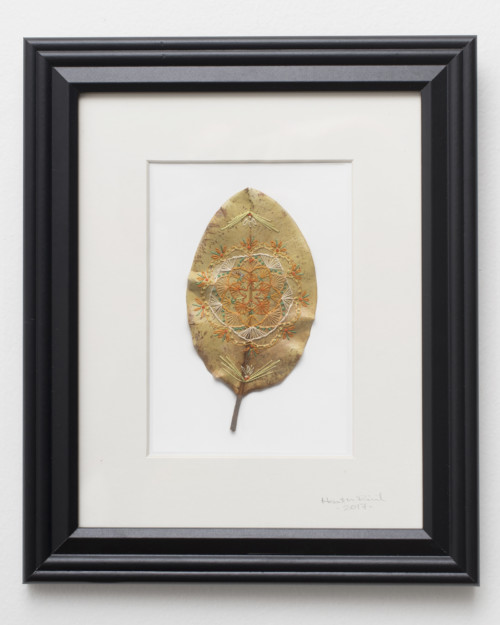
Embroidered Magnolia Leaves Could Be The Next Wave on Etsy
Artist Heather Riniker started embroidering Magnolia leaves almost by accident. “It was my last year at Savannah College of Art and Design, in a senior portfolio class, and my professor had us do an exercise wherein we choose a handful of words out of an envelope,” she recalls. “I think I came up with ’embroidery,’ ‘paper,’ ‘nature,’… I don’t remember all the words, but I had a needle and thread with me in class, so I just started embroidering on paper, and whatever I did then looked like a leaf. Suddenly I realized, ‘Oh my gosh–I can embroider on leaves!’”
“I’m very outdoorsy and I think often about nature, and I had done lot of research about making art with non-conventional items,” she continues. “So I was thinking about all these things when I said to my professor, ‘I’ll be right back’. Then, I ran outside, grabbed a leaf, and started embroidering.”
Below, Riniker and GC discuss the beautiful embroidered magnolia leaves that resulted from this process.
GC: I’ve never seen anything like your embroidering on leaves. What’s your artistic background?
HR: I went to art school at Savannah College of Art and Design, and I originally studied architecture. I was a little afraid of computers, so I was doing traditional courses. I’m not very good with technology, so I tried out the major called “Fibers” and I thought ‘I’ll just try the intro course’. I did, and I loved it because was so tactile, and I got to use my hands— no computers.
GC: What has the reaction to your work been like? Are people as surprised as I am to realize these are real leaves?
HR: So, I’m literally just starting this up. I had a job, and I hadn’t really done any art on my own since I graduated in 2013, and I was missing it. Over the summer I moved from Savannah to Atlanta, and I had some down time. I really wanted to get back into embroidering again because it’s simple, I can take it with me anywhere, and it doesn’t really cost me a lot to make.
I started making a collection over the summer– I made three of them, and they sold. I got some more interest from other people, so I made another collection, and that also sold. Then, someone saw me doing it in a Starbucks and I’m actually making him one now– a custom order. The ones you’ve probably seen are the ones that have mandala designs, but this guy was like, ‘Hey, can you do a cross?’ And I was like ‘Sure, why not?’ So I’m currently working on that one. I’d like to build this into [a more expanded portfolio] as the mandalas take me up to 16 or 18 hours to make.
GC: I wanted to ask about the integrity of the leaf. I haven’t handled too many magnolia leaves in my life, but I’m curious how they hold up to the needle. What’s the texture like?
HR: The really great thing about a magnolia leaf is that it’s a waxy leaf and it’s very thick. I have to search for leaves that are yellow, the ones that have already fallen off the tree and are now in the process of death. One I start embroidering it, and the leaf actually dries around the embroidery. With it being yellow and still alive, they give me a little more give. Sometimes if the leaf is super curved, I will put it in a book for half a day. I like it to dry in its natural shape, but I also have to consider getting it into a frame, so I have to flatten it first so that it won’t crack. It’s a hard leaf, so it’s not like a maple that’s going to crumble in your hands.
GC: Looking at other traditional arts and artisanal crafts, everything from making wool to drying animal skins, there’s always a certain knowledge you have to have about how the material holds up to the process.
HR: Everyone asks me how to preserve them, and I looked up some processes but the processes to preserve leaves are simply to put them in a book, or put them in wax paper or laminate them. I think that magnolias are so thick anyway that they are naturally durable. I made some back in 2012 and I gave them as gifts to my family, and they all still have their framed leaves and they’re perfect in the frames.
GC: What happened the first time you did this?
HR: I just started by embroidering the veins because I didn’t know what to do, and first I made about 20 of those. I framed all of those in shadow boxes, and that’s how it started. A year went by, and I wasn’t doing anything creative and I just wanted to come back to that creativity, which is why I started up again. I really wanted to do something that went back to my degree, my passion, and the fact that I love drawing, color, and design– all of this brought me back to the mandala idea.
GC: That’s a beautiful way to sum up the journey– it all comes back full circle.
Heather Riniker is @magnoliaheather on Instagram.



































